

Columbus cubes. Do you remember how Columbus had put an egg on the peak ?

So, do the same with a cube The problem was solved by Steve Biddle. He cut a corner of the cube. You can see every possible combination of truncation of a cube - from the cube (every vertex unharmed) to the cubooctahedron (every vertex truncated). And the most amazing efect of joining the partialy truncated cubes - the ring of five intersected cubes. Above models are based on creation of Steve Biddle (Steve and Megumi Biddle, The New Origami, St. Business Card Origami. Business Card Columbus Cube. Kusudama - Wiki. Two variations of kusudama The Japanese kusudama (薬玉; lit. medicine ball) is a paper model that is usually (although not always) created by sewing multiple identical pyramidal units (usually stylized flowers folded from square paper) together through their points to form a spherical shape.

Alternately the individual components may be glued together. (e.g. the kusudama in the lower photo is entirely glued, not threaded together) Occasionally, a tassel is attached to the bottom for decoration. Kusudama originate from ancient Japanese culture, where they were used for incense and potpourri; possibly originally being actual bunches of flowers or herbs. The word itself is a combination of two Japanese words kusuri, Medicine, and tama, Ball. Sparkle Kusudama (Design by Tadashmi Mori) Season's Greetings Everyone!
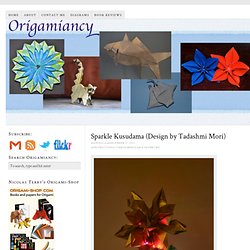
Compliments of the Season to all of you! I have made it a point to have an Origami Star as my Christmas Tree Topper for the last couple of years and have continued with that for this year, too. I usually select a 3D model of a star, and mostly Modular, so that I can place it on the top most leaf / branch sticking out of my tree. I chose Tadashi Mori’s Kusudama Sparkle to adorn my tree for this year. This is quite easy to fold and it has a pretty solid assembly. So, back to Tadashi Mori’s Sparkle Kusudama… This is an ingenious model which has a very interesting folding sequence. Paper to use: The size of the paper really depends on how large you would like your finished model to be. I used Pearl Tissue-foil Paper – 40×40 cm (15.75″x15.75″) from Nicolas Terry’s shop.
If you would like a brighter star, you can choose the Gold colored tissue foil paper from Nicolas Terry’s shop. How to fold the Sparkle Kusudama: Tadashi Mori’s instructions are clear and detailed. Origami - Folding Instructions. Origami Kusadama Flowers. Little Roses Kusudama - diagram. Video on How to Make a Kusudama With the Carambola Flower by Carmen Sprung. This Kusudama can be considered modular origami, and it is based on a beautiful flower model, folded from a pentagon and originally created by Carmen Sprung (Germany).
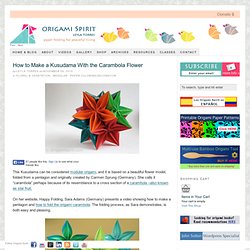
She calls it “carambola” perhaps because of its resemblance to a cross section of a carambola –also known as star fruit. On her website, Happy Folding, Sara Adams (Germany) presents a video showing how to make a pentagon and how to fold the origami carambola. The folding process, as Sara demonstrates, is both easy and pleasing. The Kusudama structure is that of a dodecahedron and made with twelve pentagonal flowers. It can be used as a holiday decoration or given as given as a handmade Christmas gift. Extra Tips to Make the Carambola and Kusudama: When folding the paper to make the pentagons, use the first piece of paper folded (picture 1) as a template by placing each of the other pieces above it and then folding (pictures 2 and 3).
The paper used was “Tant” and the color I applied to this paper was oil pastel. Six paper flowers. It got into my head that I needed to make some paper flowers.
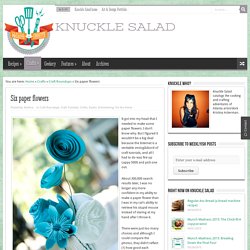
I don’t know why. But I figured it wouldn’t be a big deal because the Internet is a veritable smörgåsbord of craft tutorials, and all I had to do was fire up Lappy 5000 and pick one out. About 300,000 search results later, I was no longer any more confident in my ability to make a paper flower than I was in my cat’s ability to retrieve his stupid mouse instead of staring at my hand after I throw it. There were just too many choices and although I could compare the photos, they didn’t reflect (1) how good each tutorial was, (2) how closely my flower would resemble the picture, or (3) which flowers would look nice together.
Origami Kusudama Flower Folding Instructions - How to make an Origami Kusudama Flower. Kusudama (translated as "medicine ball") were traditionally used as incense and poutpurri, from real flowers or herbs.
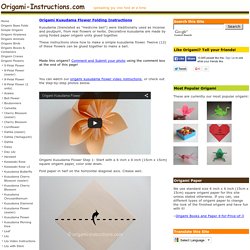
Decorative kusudama are made by using folded paper origami units glued together. These instructions show how to make a simple kusudama flower. Twelve (12) of these flowers can be glued together to make a ball. Made this origami? Comment and Submit your photo using the comment box at the end of this page! You can watch our origami kusudama flower video instructions, or check out the step-by-step photos below. Origami Kusudama Flower Step 1: Start with a 6 inch x 6 inch (15cm x 15cm) square origami paper, color side down. Fold paper in half on the horizontal diagonal axis. Origami Kusudama Flower Step 2: Now fold both the right and left corners to the top. Hurricane Kusudama Instructions 002. Me! - modular origami. The kusudama is a paper model that I usually created by connecting multiple units together.
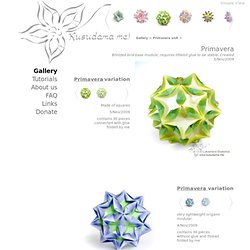
The individual pieces may be glued, sewed or connected with themselves. The complete kusudama may be decorated with tassels, beads, feathers and anything you can imagine. Kusudama originate from ancient Japanese culture, where they were used for incense like a talismans against evil. It's possible that they were originally the bunches of flowers and herbs. The word kusudama itself is a combination of two Japanese words kusuri, Medicine, and tama — Ball.
Nowadays kusudama has become a beautiful gift and an interesting hobby. All models are rather simple if you follow the diagram.